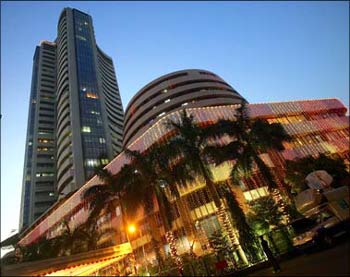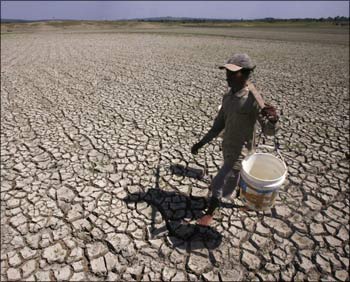
We are approaching the first anniversary of the Lehman Brothers collapse. Lehman's filing for bankruptcy on September 15 last year triggered the near-collapse of the western financial system and sent the global economy into a tailspin from which it is only now beginning to pull out.
The crisis had been building up from about the middle of 2007, when the US housing bubble got pricked, and grew in intensity till the earthquake of a year ago.
A year later, with the slow recovery of the global economy a fact of life, it is a good time to look at what happened in India, and what conclusions we can draw.
What became obvious is that India was closely linked to the world economy -- a global crisis meant an Indian crisis too. GDP growth tanked by 3 percentage points in the quarter after the Lehman collapse (compared to a year earlier, and the same level of fall as in China).

Credit became scarce, and exports then fell for 10 months in a row, the rate of fall being an extraordinary 25-30 per cent and more. The steam went out of the stock market as share index levels dropped 60 per cent, the inflation curve dipped well below zero, jobs evaporated, and pay cuts became the order of the day.
Loan delinquency rose to levels not seen in India as over-leveraged customers fell behind their schedule of payments for houses, cars and credit card bills. Businesses slipped into crisis mode, and many shrank visibly or changed hands.
But in all the dust raised by the mayhem of a world in crisis, we have missed seeing the real story -- which is the strength and bounce that is now there in the Indian system.

In the worst quarter of the last two crisis years, immediately after the Lehman collapse, India's GDP growth was 5.8 per cent.
Amazingly, that was the average growth achieved by India during the quarter-century before take-off happened five years ago. So the worst is now what used to be the average.
India remains the second fastest growing economy in the world today, behind only China. This when, out of more than 40 of the largest economies in the world, only eight are growing -- with Saudi Arabia, Egypt and Indonesia in the 4-5 per cent range, and Pakistan with 2 per cent.
Now, despite a widespread drought adding to the woes of the industrial recession, GDP growth in 2009-10 is still expected to top 6 per cent. Compare that with growth in previous drought years: 4 per cent in 2002-03 and 3.3 per cent in 1987-88.

In the 1970s, GDP used to actually shrink in drought years (1972-73 and 1979-80).
This message of resilience and buoyancy has been missed in the focus on the steady flow of bad news, from financial crisis to economic recession to agricultural drought.
If 6 per cent is the new floor, then it is safe to say that the sustainable average rate of GDP growth could easily be 8.5 per cent.
Indeed, that figure might be achieved as early as next year, because of the rebound from a poor crop year.

Remember that the last two rebound years saw growth of 8.5 per cent (2003-04) and 9.8 per cent (1988-89).
In fact, in projecting average growth of 7.8 per cent during the 11th Plan period (2007-12), the Planning Commission is implicitly forecasting growth next year and the year after at 8.5 per cent.
In other words, once the drought and its difficult fall-out are dealt with, good times should be round the corner.